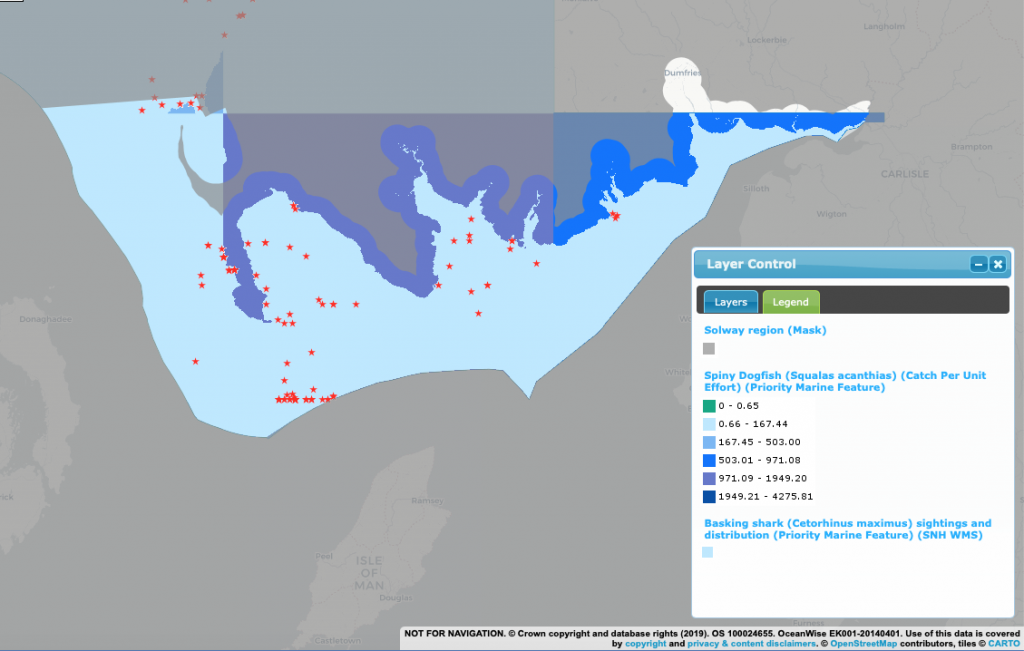Sharks, skates and rays
References
Dulvy, N., Notarbartolo di Sciara, G., Serena, F., Tinti, F., Ungaro, N., Mancusi, C. & Ellis, J. (2015). Common Skate – Dipturus batis (European Assessment). The IUCN Red List of Threatened Species. Available here. (Accessed: 14.07.20)
Dulvy, N.K., Notarbartolo di Sciara, G., Serena, F., Tinti, F. & Ungaro, N., Mancusi, C. & Ellis, J. (2006). Common Skate – Dipturus batis (Global Assessment). The IUCN Red List of Threatened Species. Available here. (Accessed: 08.04.20)
Ellis, J. (2016). Thornback Skate – Raja clavata (Global Assessment). The IUCN Red List of Threatened Species. Available here. (Accessed: 08.04.20)
Ellis, J., Soldo, A., Dureuil, M. & Fordham, S. (2015). Spiny Dogfish – Squalus acanthias (European Assessment). The IUCN Red List of Threatened Species. Available here. (Accessed: 14.07.20)
Ellis, J., Farrell, E., Jung, A., McCully, S., Sims, D. & Soldo, A. (2015). Porbeagle Shark – Lamna nasus (European Assessment). The IUCN Red List of Threatened Species. Available here. (Accessed: 14.07.20)
Fordham, S., Fowler, S.L., Coelho, R.P., Goldman, K. & Francis, M.P. (2016). Spiny Dogfish – Squalus acanthias (Global Assessment). The IUCN Red List of Threatened Species. Available here. (Accessed: 08.04.20)
International Union for Conservation of Nature and Natural Resources (2019). Red List of Threatened Species. Available here. (Accessed: 13.03.18)
Joint Nature Conservation Committee and the Department of Environment, Food and Rural Affairs (on behalf of the Four Countries’ Biodiversity Group). (2012). UK Post-2010 Biodiversity Framework. Available here. (Accessed: 07.07.18)
Joint Nature Conservation Committee (2007a). Report on the Species and Habitat Review (UK BAP) Available here. (Accessed: 07.03.18)
Joint Nature Conservation Committee (2007b). UK Biodiversity Action Plan Priority Marine Species. Available here. (Accessed: 07.03.18)
Joint Nature Conservation Committee (1994). UK Biodiversity Action Plan. Available here. (Accessed: 27.11.19)
Marine Conservation Society Website (n.d). Spiny Dogfish- Squalus acanthus. Available here. (Accessed: 08.04.20)
Marine Management Organisation. (n.d.). Marine Planning Evidence Base. Available here. (Accessed: 14.05.18)
Marine Scotland (n.d.). Scotland’s National Marine Plan Interactive. Available here. (Accessed: 06.08.19)
McCully, S., Dureuil, M. & Farrell, E. (2015). Tope – Galeorhinus galeus (European Assessment). The IUCN Red List of Threatened Species. Available here. (Accessed: 14.07.20)
McCully, S., Ellis, J., Walls, R. & Fordham, S. (2015). Sandy Skate (Ray) – Leucoraja circularis (Global and European Assessment). The IUCN Red List of Threatened Species. Available here. (Accessed: 08.04.20)
Mills, F., Sheridan, S. and Brown S. (2017). Clyde Marine Region Assessment. Clyde Marine Planning Partnership. pp 231, Available here. (Accessed: 14.05.18)
Natural England (2010). Habitats and Species of Principal Importance List. Available here. (Accessed: 03.12.19)
NatureScot (2020). Priority Marine Features in Scotland’s Seas. Available here. (Accessed: 04.05.21)
NatureScot (2020). Scottish Biodiversity List. Available here. (Accessed: 04.05.21)
Oceana (2009). Keeping the Balance, How Environmental Conventions can be used to protect sharks and their habitats. Available here. (Accessed: 08.04.20)
Oceana Website (n.d.). Spiny Dogfish. Available here. (Accessed: 08.04.20)
Ocean Biodiversity Information System (n.d.). Available here. (Accessed: 22.06.20)
OSPAR Commission (n.d.). List of Threatened and/or Declining Species and Habitats. Available here. (Accessed: 12.03.18)
Rigby, C.L., Barreto, R., Carlson, J., Fernando, D., Fordham, S., Francis, M.P., Herman, K., Jabado, R.W., Liu, K.M., Marshall, A., Pacoureau, N., Romanov, E., Sherley, R.B. & Winker, H. (2019). Porbeagle – Lamna nasus (Global Assessment). The IUCN Red List of Threatened Species. Available here. (Accessed: 08.04.20)
Rigby, C.L., Barreto, R., Carlson, J., Fernando, D., Fordham, S., Francis, M.P., Herman, K., Jabado, R.W., Liu, K.M., Marshall, A., Romanov, E. & Kyne, P.M. (2019). Basking Shark – Cetorhinus maximus (Global Assessment). The IUCN Red List of Threatened Species. Available here. (Accessed: 08.04.20)
Rigby, C.L., Barreto, R., Carlson, J., Fernando, D., Fordham, S., Francis, M.P., Herman, K., Jabado, R.W., Liu, K.M., Marshall, A., Pacoureau, N., Romanov, E., Sherley, R.B. & Winker, H. (2019). Blue Shark – Prionace glauca (Global Assessment). The IUCN Red List of Threatened Species. Available here. (Accessed: 14.07.20)
Scottish Government (2013). Scottish Biodiversity List. Available here. (Accessed: 09.01.20)
Serena, F., Mancusi, C., Clò, S., Ellis, J. & Valenti, S.V. (2009). Common Smoothhound – Mustelus mustelus (Global Assessment). The IUCN Red List of Threatened Species. Available here. (Accessed: 08.04.20)
Sims, D., Fowler, S.L., Clò, S., Jung, A., Soldo, A. & Bariche, M. (2015). Basking Shark – Cetorhinus maximus (European Assessment). The IUCN Red List of Threatened Species. Available here. (Accessed: 15.07.20)
Sims, D., Fowler, S.L., Ferretti, F. & Stevens, J.D. (2015). Blue Shark – Prionace glauca (European Assessment). The IUCN Red List of Threatened Species. Available here. (Accessed: 08.04.20)
Solway Firth Partnership (n.d.) Recreational sea angling. Available here. (Accessed: 08.04.20)
Solway Firth Partnership (1996). The Solway Firth Review, Solway Firth Partnership, Dumfries. Available here. (Accessed 23.07.19)
UK National Ecosystem Assessment (2011). The UK National Ecosystem Assessment Technical Report. UNEP-WCMC, Cambridge. Available here. (Accessed: 28.05.18)
Walker, T.I., Rigby, C.L., Pacoureau, N., Ellis, J., Kulka, D.W., Chiaramonte, G.E. & Herman, K. (2020). Tope – Galeorhinus galeus (Global Assessment). The IUCN Red List of Threatened Species. Available here. (Accessed: 08.06.20)
In-Text References;
Baxter, J.M., Boyd, I.L., Cox, M., Donald, A.E., Malcolm, S.J., Miles, H., Miller, B., Moffat, C.F., (Editors), (2011). Scotland’s Marine Atlas: Information for the national marine plan. Marine Scotland, Edinburgh. pp 191. Available here. (Accessed: 22.07.19)
Marine Conservations Society (n.d.). Blue Shark – Prionace glauca. Available here. (Accessed: 24.06.20)
Image; Boat on the Solway. © Solway Firth Partnership. Photographer; Colin Tennant





